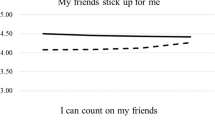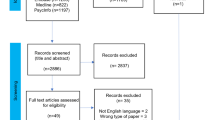Abstract
Background
During adolescence, friends are increasingly important for support and values. Do friends also have a long-term impact on suicidality? This study explored the role of friendship problems (e.g., social isolation) and deviant friends during late adolescence on suicidal ideation and behavior 3 years later.
Method
Participants were 295 community adolescents (59 % Mexican-American; 41 % European-American) from the United States. Information about their suicidal ideation and behavior, depression, friendship problems, and deviant friends was collected at baseline and at a 3-year follow-up.
Results
Having deviant friends was a better predictor of suicidality than having friendship problems, with variability by sex and ethnicity. Having deviant friends predicted suicidal ideation among Mexican-American adolescents. Having friends who were disconnected from school was a risk factor for suicidal ideation among European-American adolescents but a protective factor for suicidal behavior among Mexican-American adolescents, especially boys. Depression played more of a mediating role between friendship factors and suicidality for European-American than for Mexican-American adolescents.
Conclusions
This study’s findings suggest an influence of adolescents’ deviant friends on suicidality 3 years later. They also call for the cultural and gender grounding of suicide theory, research and prevention.
Similar content being viewed by others
Notes
The term “suicidality” refers to suicidal ideation and/or behavior. “Nonfatal suicidal behavior” (in lieu of "suicide attempts") refers to suicidal acts that a person survived, and "suicide" (in lieu of "completed or successful suicide”) to suicidal acts that resulted in death. This terminology avoids the problematic message, implicit in traditional terminology that surviving a suicidal act represents a failure and, conversely, that killing oneself is a success (see Canetto [5], Canetto and Lester [7] for an analysis of suicidal behavior terminology).
References
Bearman PS, Moody J (2004) Suicide and friendships among American adolescents. Am J Public Health 94:89–95
Beautrais A (2003) Life course factors associated with suicidal behaviors in young people. Am Behav Sci 46:1137–1156
Borowsky IW, Ireland M, Resnick MD (2001) Adolescent suicide attempts: risks and protectors. Pediatrics 107:485–496
Buhrmester D (1990) Intimacy of friendship, interpersonal competence, and adjustment during preadolescence and adolescence. Child Dev 61:1101–1111
Canetto SS (1997) Meanings of gender and suicidal behavior during adolescence. Suicide Life Threat Behav 27:339–350
Canetto SS (2008) Women and suicidal behavior: a cultural analysis. Am J Orthopsychiatry 78:259–266
Canetto SS, Lester D (1998) Gender, culture and suicidal behavior. Transcult Psychiatry 35:163–191
Canino G, Roberts R (2001) Suicidal behavior among Latino youth. Suicide Life Threat Behav 31:122–131
Centers for Disease Control and Prevention (2008) Strategic direction for the prevention of suicidal behavior: promoting individual, family and community connectedness to prevent suicidal behavior. US Department of Health and Human Services, Atlanta http://www.cdc.gov/ViolencePrevention/pdf/Suicide_Strategic_Direction_Full_Version-a.pdf Accessed 29 Dec 2011
Centers for Disease Control and Prevention [CDC] (2008) Youth risk behavior surveillance: United States, 2007 (surveillance summaries No. SS-4). US Department of Health and Human Services, Atlanta
Centers for Disease Control and Prevention (2004). Methodology of the youth risk behavior surveillance system (MMWR Series No. RR-12). Atlanta, GA: U.S. Department of Health and Human Services
Chavez EL, Oetting ER, Swaim RC (1994) Dropout and delinquency: Mexican-American and Caucasian Non-Hispanic youth. J Clin Child Psychol 23:47–55
Cook TD, Deng Y, Morgano E (2007) Friendship influences during early adolescence: the special role of friends’ grade point average. J Res Adolesc 17:325–356
Crosnoe R, McNeely C (2008) Peer relations, adolescent behavior, and public health research and practice. Family Community Health S31:S71–S80
DiFilippo JM, Overholser JC (2000) Suicidal ideation in adolescent psychiatric inpatients as associated with depression and attachment relationships. J Clin Child Psychol 29:155–166
Dishion TJ, Owen LD (2002) A longitudinal analysis of friendships and substance use: bidirectional influence from adolescence to adulthood. Dev Psychol 38:480–491
Duarte-Velez YM, Bernal G (2007) Suicide behavior among Latino and Latina adolescents: conceptual and methodological issues. Death Stud 31:435–455
Fortuna LR, Perez DJ, Canino G, Sribney W, Alegria M (2007) Prevalence and correlates of lifetime suicidal ideation and suicide attempts among Latino subgroups in the United States. J Clin Psychiatry 68:572–581
Gibson C, Jung K (2002) Historical census statistics on population totals by race, 1790 to 1990, and by Hispanic origin, 1970–1990, for the United States, regions, divisions, and states (working paper series no. 56). US Census Bureau, Washington, DC
Hacker KA, Suglia SF, Fried LE, Rappaport N, Cabral H (2006) Developmental differences in risk factors for suicide attempts between ninth and eleventh graders. Suicide Life Threat Behav 36:154–166
Hartup WW (1996) The company they keep: friendships and their developmental significance. Child Dev 67:1–13
Haynie DL, South SJ, Bose S (2006) Residential mobility and attempted suicide among adolescents: an individual-level analysis. The Sociol Q 47:693–721
Johnson JG, Cohen P, Gould MS, Kasen S, Brown J, Brook JS (2002) Childhood adversities, interpersonal difficulties, and risk for suicide attempts during late adolescence and early adulthood. Arch Gen Psychiatry 59:741–749
Kaminski JW, Puddy RW, Hall DM, Cashman SY, Crosby AE, Ortega LAG (2010) The relative influence of different domains of social connectedness on self-directed violence in adolescence. J Youth Adolesc 39:460–473
Kerr DCR, Preuss LJ, King CA (2006) Suicidal adolescents’ social support from family and peers: gender-specific associations with psychopathology. J Abnorm Child Psychol 34:103–114
Kessler RC, Berglund P, Borges G, Nock M, Way PS (2005) Trends in suicide ideation, plans, gestures, and attempts in the United States, 1990–1992 to 2001–2003. J Am Med Assoc 293:2487–2495
Kobus K, Reyes O (2000) A descriptive study of urban Mexican American adolescents’ perceived stress and coping. Hispanic J Behav Sci 22:163–178
McNeely C, Falci C (2004) School connectedness and the transition into and out of health-risk behavior among adolescents: a comparison of social belonging and teacher support. J Sch Health 74:284–292
Munsch J, Wampler R (1993) Ethnic differences in early adolescents’ coping with school stress. Am J Orthopsychiatry 63:633–646
National Center for Education Statistics (2003) Status and trends in the education of Hispanics (NCES publication no. 2003–2008). US Government Printing Office, Washington, DC
Oetting ER, Beauvais F (1984) The drug and alcohol assessment system: Book II: instrument development, reliability, and validity. Rocky Mountain Behavioral Sciences Institute, Fort Collins
Oetting ER, Beauvais F (1986) Peer cluster theory: drugs and the adolescent. J Counsel Dev 65:17–22
Preacher KJ, Hayes AF (2004) SPSS and SAS procedures for estimating indirect effects in simple mediation models. Behav Res Methods Instrum Comput 36:717–731
Prinstein MJ (2003) Social factors: peer relationships. In: Spirito A, Overholser JC (eds) Evaluating and treating adolescent suicide attempters. Academic Press, San Diego, pp 193–209
Prinstein MJ (2007) Moderators of peer contagion: a longitudinal examination of depression socialization between adolescents and their best friends. J Clin Child Adolesc Psychol 36:159–170
Prinstein MJ, Boergers J, Spirito A (2001) Adolescents’ and their friends’ health-risk behavior: factors that alter or add to peer influence. J Pediatr Psychol 26:287–298
Prinstein MJ, Boergers J, Spirito A, Little TD, Grapentine WL (2000) Peer functioning, family dysfunction, and psychological symptoms in a risk factor model for adolescent inpatients’ suicidal ideation severity. J Clin Child Psychol 29:392–405
Rumberger RW (1987) High school dropouts: a review of issues and evidence. Rev Educational Res 57:101–121
Sánchez B, Colón Y, Esparza P (2005) The role of sense of school belonging and gender in the academic adjustment of Latino adolescents. J Youth Adolesc 34:619–628
Sobel ME (1982) Asymptotic confidence intervals for indirect effects in structural equation models. In: Leinhard S (ed) Sociological methodology 1982. Jossey-Bass, San Francisco, pp 290–312
Steinberg L, Dornbusch SM, Brown BB (1992) Ethnic differences in adolescent achievement: an ecological perspective. Am Psychol 47:723–729
Substance Abuse and Mental Health Services Administration [SAMHSA] (2009) The NSDUH report: suicidal thoughts and behaviors among adults. US Department of Health and Human Services, Rockville
Swanson CB (2001) Who graduates? Who doesn’t? A statistical portrait of public high school graduation, class of 2001. The Urban Institute, Washington, DC
Tani CR, Chavez EL, Deffenbacher JL (2001) Peer isolation and drug use among White, non-Hispanic and Mexican-American adolescents. Adolescence 36:127–139
Thompson M, Kuruwita C, Foster M (2009) Transitions in suicide risk in a nationally representative sample of adolescents. J Adolesc Health 44:458–463
Thompson MP, Light LS (2011) Examining gender differences in risk factors for suicide attempts made 1 and 7 years later in a nationally representative sample. J Adolesc Health 48:391–397
Umberson D, Crosnoe R, Reczek C (2010) Social relationships and health behavior across the life course. Annu Rev Sociol 36:139–157
United States Census Bureau (2002) Hispanic origin (of any race), for the United States, regions, divisions, and states: 1990 (100-percent data). http://www.census.gov/population/documentation/twps0056/tabD-01.pdf. Retrieved 20 May 2007
Vega WA, Gil AG, Zimmerman RS, Warheit GJ (1993) Risk factors for suicidal behavior among Hispanic, African-American, and Non-Hispanic, White boys in early adolescence. Ethn Dis 3:229–241
Way N, Cowal K, Gingold R, Pahl K, Bissessar N (2001) Friendship patterns among African-American, Asian-American, and Latino adolescents from low-income families. J Soc Personal Relatsh 18:29–53
Way N, Greene ML (2006) Trajectories of perceived friendship quality during adolescence: the patterns and contextual predictors. J Res Adolesc 16:293–320
Way N, Robinson MG (2003) A longitudinal study of the effects of family, friends, and school experiences on the psychological adjustment of ethnic minority, low-SES adolescents. J Adolesc Res 18:324–346
Windle M (1994) A study of friendship characteristics and problem behaviors among middle adolescents. Child Dev 65:1764–1777
Winterrowd E, Canetto SS, Chavez E (2011) Friendship factors and suicidality: common and unique patterns in Mexican- and European-American youth. Suicide Life Threat Behav 41:50–65
Zayas LH, Pilat AM (2008) Suicidal behavior in Latinas: explanatory cultural factors and implications for intervention. Suicide Life Threat Behav 38:334–342
Acknowledgments
The data for this study came from a study funded by the National Institute on Drug Abuse via Research Grant No. NIDA DA 06293, awarded to Ernest L. Chavez and his collaborators. The authors thank Ernest L. Chavez for access to the data, and for comments on early versions of this study.
Author information
Authors and Affiliations
Corresponding author
Rights and permissions
About this article
Cite this article
Winterrowd, E., Canetto, S.S. The long-lasting impact of adolescents’ deviant friends on suicidality: a 3-year follow-up perspective. Soc Psychiatry Psychiatr Epidemiol 48, 245–255 (2013). https://doi.org/10.1007/s00127-012-0529-2
Received:
Accepted:
Published:
Issue Date:
DOI: https://doi.org/10.1007/s00127-012-0529-2




